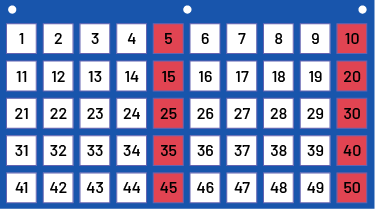B1.3 Compare and order whole numbers up to and including 50, in various contexts
Activity 1: Math Centre for Ordering Numbers

Materials
- containers or bags containing small objects (10 to 50)
- egg cartons or ice cube trays
- numbered cards (from 10 to 50)
In a math centre, put three or four bags (containers) of objects with different quantities (for example, 13, 24 and 30).
Invite students to count the objects in each bag by placing one object in each section of the egg cartons (or ice cube trays) and matching a number card with it.
Ask students to put the numbers in ascending or descending order.
Note: Using materials such as egg cartons (or ice cube trays) gives students a visual cue to compare and order quantities.
Source: adapted and translated from L’@telier - Ressources pédagogiques en ligne (atelier.on.ca).
Activity 2: Compare Neighbours of Numbers
Display a number grid or pocket chart (see image below) displaying numbers from 1 to 50.

Circle or highlight a number, for example 37.
Tell students that they are going to compare it with the numbers around it. Ask them to look at the number to the right, to the left, above and below.
Ask students what they notice about the "neighbours" of this number.
Discuss the relationships between the circled or highlighted number and those that touch it. By discussing these relationships, one can establish that the number to the left is "one less", the number below is "10 more", etc.
Afterwards, give students a blank 10 x 5 grid with some numbers written on it.
| 1 | |||||||||
| 13 | |||||||||
| 32 | |||||||||
| 47 | 50 |
Ask students to find the "neighbours" of the numbers, namely, those to the left, to the right, above, and below that number.
Source: adapted and translated from L’@telier - Ressources pédagogiques en ligne (atelier.on.ca)
Activity 3: What's Hidden?
Show students the number line below with a series of hidden numbers.

Ask students to look at the number line and visualize the hidden numbers.
Ask students to discuss the hidden numbers with a peer.
Share the results with the class and ask students to explain how they determined the hidden number series.
Ask students the following question: How did you find the numbers hidden under the rectangle?
Afterwards, introduce students to a new number line.

Ask students the following questions:
- What number would be at X? What number would be at Y? How do you know?
- Which number would be at A? What number would be at B? How do you know?
Invite them to complete the number line.
Consolidation helps students discuss their process and use the vocabulary before, after, more than, less than, etc.
Source: translated from Guide d’enseignement efficace des mathématiques de la 1re à la 3e année, Numération et sens du nombre, p. 79.
Activity 4: Compare and Order Dot Plates
Use Appendix 1Q.4 (Dot Plates) to prepare number plates with dots using stickers or bingo markers.
Use plates as flashcards during group activities. Show a plate for only a second, then ask students the following question: How many dots did you see?
Show two dot plates and ask students to compare their quantities.
Hand a group of students a set of plates and invite them to put the plates in ascending or descending order by the number of dots.
Give each student a dot plate. Ask them to walk around with their plate and compare it with the plates of three different peers; for example, 5 is smaller than 7, your plate has two more dots than mine.
Give each student a dot plate. Ask half the class to stand up and make a line in ascending order with their plate.
Have the other students observe and determine if they are correctly placed by quantity on their plate.
Repeat the steps, alternating the roles of the two groups.
Source: adapted and translated from Guide d’enseignement efficace des mathématiques de la 1re à la 3e année, Numération et sens du nombre, p. 106-107.
Note: This activity can be modified to invite students to compare and order other materials, such as ten frames.
Activity 5: Numbers that Move
Ask students to write a number from 5 to 50 on their small whiteboard or on a piece of paper.
Divide students into two groups.
One of the groups stands up and puts themselves in ascending or descending order by looking at the numbers written on their board/paper. When students are finished, the others look at the numbers and determine if they are in order.
Repeat the same steps, alternating groups.
